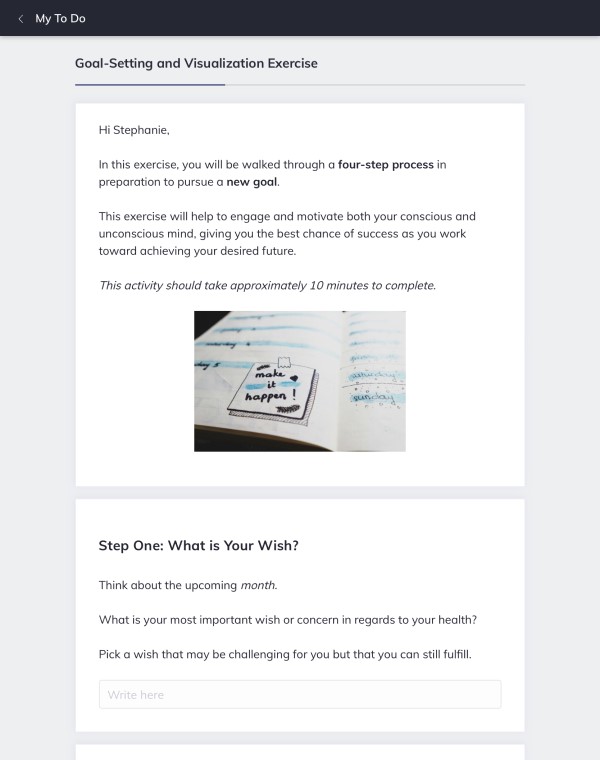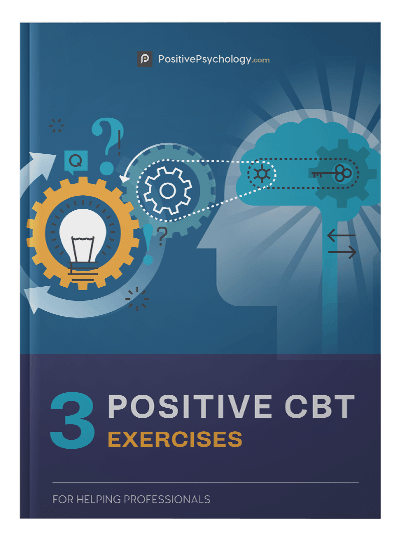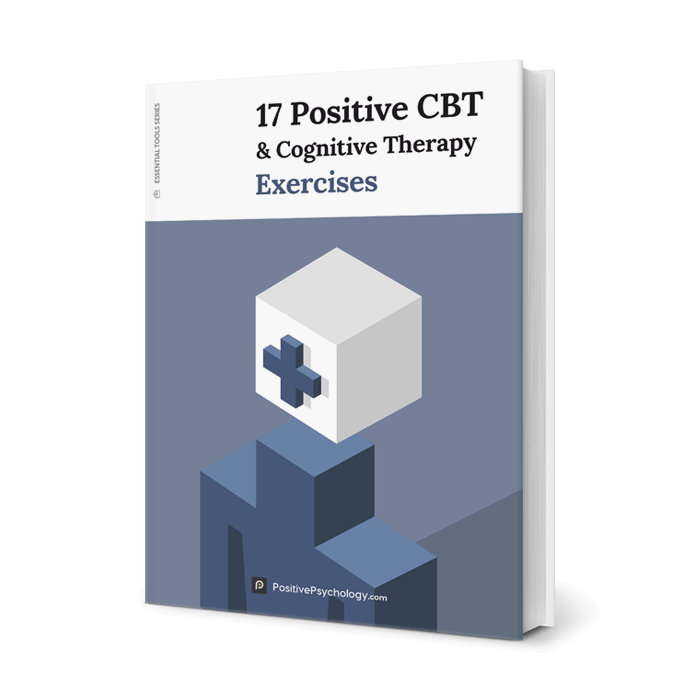What Is Mental Contrasting and How Can We Benefit From It?
 If you’ve ever wondered…
If you’ve ever wondered…
What’s with all the hype about positive thinking?
… you’re not alone.
Self-help movements have touted the benefits of visualization and a positive mindset to the point of triggering a countermovement that warns against the effects of toxic positivity, referring to the practice of unrealistic optimism and the false belief that negative emotions are not okay.
Indeed, there is a growing acknowledgment among scholars that thinking solely about sunshine and daisies may not be sensible nor helpful during difficult times.
But recent research suggests there may be a useful alternative in the simple practice of mental contrasting.
In this article, we will take a closer look at the process of mental contrasting, consider its benefits, and outline how to practice it across different life domains.
Before you continue, we thought you might like to download these Positive CBT Exercises for free. These science-based exercises will provide you with detailed insight into positive Cognitive-Behavioral Therapy (CBT) and give you the tools to apply it in your therapy or coaching.
This Article Contains:
What Is Mental Contrasting?
To explain mental contrasting, let’s first explore the principles of fantasy realization theory.
In her description of the theory, Oettingen (1999), highlights that a person can maximize their commitment to goals by balancing positive and negative perspectives of an impending reality.
The style of thinking that focuses on the positive aspects of an impending reality is referred to as free fantasy.
Free fantasies are imagined future events or behaviors that do not consider the likelihood of their actual occurrence (Klinger, 1990). For instance, a person may fantasize about receiving a promotion and getting a new corner office, even if this is unlikely to happen in reality.
In contrast, a person may focus on the negative aspects of a future situation, such as the late hours that would inevitably go into earning such a promotion.
According to Oettingen (1999), a person may deal with their fantasies and impending reality in one of three ways. The chosen approach will impact that person’s readiness and likelihood of making their fantasy a reality via goal pursuit and achievement.
First, a person may simply indulge in positive fantasies about the future and ignore the downsides of an impending reality.
Second, a person may solely reflect on the negative aspects of a future reality, ignoring their positive fantasies.
The danger of both of these approaches is that they threaten to cap a person’s total possible level of commitment toward achieving a goal. To understand why, consider the following scenario:
A man wishes to buy a new Ferrari. Initially, the man may find himself captivated by images of himself driving along the coast with the roof down; he fantasizes about smiling to passersby, who are admiring his new vehicle.
This positive imagined reality may motivate him to begin saving for the car, but when the reality of how much work is involved in saving for such a lavish purchase sets in, he loses motivation and settles for a cheaper car.
An alternative scenario is that the man is considering saving for a Ferrari, but he dwells on the substantial amount of work and sacrifice that will be required to buy it: late nights at the office, disciplined budgeting, and so forth.
Consequently, these images of the reality involved in goal pursuit dampen his enthusiasm, and once again, he settles for a cheaper car.
In both scenarios, the man has failed to achieve his goal. But there is a third option.
The man could choose to balance fantasizing positively about owning a Ferrari while also contrasting these fantasies with negative aspects of his impending reality, such as the sacrifice involved in saving to make the purchase.
The process of comparing and contrasting these positive and negative aspects of an impending future is what is known as mental contrasting. And the process of mental contrasting is valuable, as it triggers expectancies that can guide decisions about goal commitment and motivate sustained goal pursuit.
Mental contrasting and expectancy judgments
Expectancies are judgments about the likelihood that particular events will occur (Bandura, 1977). In the context of mental contrasting and fantasy realization theory, expectancies pertain to the likelihood of achieving a goal regarding a desired future.
By engaging in mental contrasting and triggering expectancy judgments, a person can avoid over-committing to a goal that is unlikely to be attained as a result of too much free fantasy, such as the reasonably unrealistic goal of becoming an overnight internet celebrity or millionaire.
Likewise, through mental contrasting, a person can avoid under-committing to a goal that is easily within reach due to focusing too narrowly on negative or challenging aspects of an impending future.
For instance, it would be a shame to give up on completing your studies just because they are challenging when you are only a semester away from obtaining your degree. And in such a case, a little fantasizing about what it would be like to attend graduation and be qualified for competitive jobs may help motivate such a student to reach the finish line.
By balancing the positive and negative aspects of an impending future, a person can strive toward goals while planning realistically for the challenges that will arise on the path to goal achievement.
The Process of Mental Contrasting
 We know from research that our subconscious mind tends to operate with a focus on short timeframes.
We know from research that our subconscious mind tends to operate with a focus on short timeframes.
It does not understand long-term goals and achievements but rather focuses on staying happy at any given moment.
With positive thinking and free fantasy, we allow our subconscious minds to indulge in the feeling that ‘everything is okay.’ This explains the immediate surge of motivation that accompanies fantasizing about desired futures.
However, such motivation is often short lived without equal consideration of the process for sustaining happiness through goal pursuit. Consequently, people may give up on their fantasies and fall into a cycle of feeling positive one moment and negative the next.
By practicing mental contrasting, such cycles can be avoided through the anticipation of challenges. For example, if an overweight person is practicing mental contrasting, they will imagine their ideal body and, at the same time, will be aware of how hard the workout sessions will likely be.
The process and the product of goal pursuit are both transparent when engaging in mental contrasting. And, as a result, the person in this scenario should be more likely to achieve their goal without giving up before their target weight is reached.
Practicing mental contrasting using WOOP
 At the core of most mental contrasting interventions is a practice Oettingen refers to as WOOP.
At the core of most mental contrasting interventions is a practice Oettingen refers to as WOOP.
Each of the four letters in the acronym WOOP stands for a step in the mental contrasting process that can help prepare an individual to sustain goal pursuit by energizing both the conscious and unconscious mind (WoopMyLife.org, n.d.).
The WOOP acronym functions as a goal-setting exercise.
Psychologists or coaches may find it helpful to build the WOOP exercise into one of their existing client-management or onboarding tools as a way to establish the focus of their sessions early in a coaching or counseling relationship.
For instance, in the visual example provided, we have built the four-step WOOP exercise into an activity that clients can complete at their convenience via smartphone or tablet using the coaching tool Quenza.
Let’s now take a closer look at each letter of the WOOP acronym.
W – Wish
Mental contrasting starts with a component of desire. In this first step, a person will be prompted to think about a key concern, desire, or wish pertaining to one life domain and visualize it.
For example, a person may wish to receive a promotion at their job or re-enter the dating scene.
O – Outcome
Next, a person is prompted to think about the ideal outcome of having their wish come true. This usually encompasses an emotional component, such as how a person will feel once their goal is accomplished or how achieving the goal would fundamentally change their life.
For example, the person who wishes for a promotion may imagine the excitement associated with the challenge of a new role. Likewise, the person looking to start dating again may imagine themselves feeling a greater sense of connectedness and joy upon meeting a prospective partner.
Importantly, the person is encouraged to really pause and allow themselves time to imagine what this outcome would feel like, energizing the mind to begin pursuing that outcome (Oettingen et al., 2009).
O – Obstacles
The third part of the process grounds the person and their goals in reality. In this step, a person reflects on the possible hurdles and difficulties they may face while striving toward their desired state.
When focusing on hurdles, a person is encouraged to focus on the internal aspects of the self that may hamper goal achievement, rather than things beyond their control. For instance, the person seeking a promotion may recognize in themselves a tendency to experience imposter syndrome or low self-confidence.
Once again, the person completing the WOOP exercise is encouraged to pause and reflect fully on such impending challenges, imagining how they would play out in reality.
P – Planning
The final stage of mental contrasting involves making an if–then plan, sometimes referred to as setting implementation intentions (Gollwitzer & Brandstätter, 1997).
The person completing the WOOP worksheet focuses on one of the obstacles they encountered in the previous stage. They are then prompted to make a plan to address it: If I encounter obstacle X, then I will respond with action Y.
For example, the person looking to re-enter the dating scene may realistically anticipate that they will experience nerves in the lead-up to a first date, tempting them to cancel. In response to this anticipated challenge, the person practicing WOOP may make a plan to talk through their anxieties with a friend or practice mindful breathing should such anxieties arise.
This is the stage that researchers suggest sets mental contrasting apart from other types of interventions. This is because it enables someone to enact a pre-planned script in the face of inevitable challenges, thereby supporting goal pursuit.
The Origins of Mental Contrasting
Oettingen conceptualized mental contrasting as an alternative to visualization techniques, which can actually be counterproductive to goal achievement.
The trouble with such techniques is that our minds are ineffective at distinguishing between fantasy and reality. This means that by solely visualizing the positive, we are lulled into a sense of complacency, allowing ourselves to feel happy and relaxed.
Consequently, we are not sufficiently activated or motivated to make desired fantasies a reality.
Positive visualization is a critical component of mental contrasting and successful goal achievement, but many books in the popular press, such as The Secret, have framed visualization, or free fantasy, as being sufficient to bring about desired change.
While there is certainly a place for positive thinking in most positive psychology interventions, Oettingen’s message is that such thinking must be balanced with realistic anticipation of hurdles to have benefits.
It was this belief that led Oettingen (2014) to publish her seminal piece in the New York Times, “The Problem With Positive Thinking.”
This thought-provoking article highlighted the findings of over 20 years of motivation research, emphasizing the dangers of free fantasy for stifling goal achievement across a range of populations and domains, including among dieters looking to lose weight, college students seeking employment, and school children pursuing good grades.
Below is a comparison of mental contrasting and positive thinking using the example of a weight-loss goal:
- Mental contrasting: Usually practiced when a problem arises.
- Example: A doctor has recommended a health intervention for weight loss.
- Positive thinking: Can be incorporated into our lifestyle in the presence or absence of problems.
- Example: Thinking positive thoughts about one’s health or body irrespective of context or circumstances.
- Mental contrasting: Imagery includes positive and negative aspects of an impending reality.
- Example: Imagining yourself becoming fit, together with the challenging reality of needing to resist unhealthy food.
- Positive thinking: Imagery pertains exclusively to the positive aspects of a future situation.
- Example: Visualizing yourself with a summer beach body without envisioning how it will be attained.
- Mental contrasting: Solution-focused, thereby guiding action.
- Example: If–then statements, such as, “If I get tempted to mindlessly snack, I will go for a short walk instead.”
- Positive thinking: Predominantly self-focused (e.g., regarding self-image, self-esteem) and may not guide action.
- Example: Saying positive affirmations in the mirror, such as, “I am doing my best to lose weight.”
- Mental contrasting: Clarifies how we can implement strategies for problem-solving.
- Example: Anticipating the challenge of attending a picnic with decadent food and planning around it.
- Positive thinking: Limited to thoughts that may or may not guide action.
- Example: Predominantly focusing on images of yourself with a different body, but not considering the hurdles to attain it.
- Mental contrasting: Practical and grounded in reality.
- Example: Expectancy judgments are triggered so a realistic assessment of whether a goal can be achieved can be made.
- Positive thinking: May not always be realistic or in line with reality.
- Example: Imagining yourself looking toned in time for summer despite being 20 pounds over your goal weight a month out from summer.
The Benefits of Mental Contrasting
 Growing scholarly evidence suggests that mental contrasting is a powerful alternative to positive thinking that effectively balances optimistic and realistic perspectives to help us achieve goals.
Growing scholarly evidence suggests that mental contrasting is a powerful alternative to positive thinking that effectively balances optimistic and realistic perspectives to help us achieve goals.
Several studies have found that encouraging clients to use mental contrasting instead of standard visualizations and imagery techniques can be highly effective.
These benefits span areas such as preventative health, romantic relationships, and self-regulation.
1. Mental contrasting and health benefits
Mental contrasting has been shown to have positive benefits as a physical and mental health intervention.
Stadler, Oettingen, and Gollwitzer (2009) assessed the benefits of a physical activity intervention by comparing the benefits of an information session with those of an information session combined with training in mental contrasting. Participants in the latter condition wrote down their plans for increasing their physical activity using the WOOP framework and were twice as physically active as the group who were only exposed to the information session.
Adriaanse et al. (2010) found that when participants practiced mental contrasting and set implementation intentions in relation to eating habits, they showed a 30% improvement in diet, surpassing the control condition.
Lastly, mental contrasting has been shown to have benefits in clinical interventions. Christiansen, Oettingen, Dahme, and Klinger (2010) tested a three-week intervention aimed at improving physical capacity among populations with chronic back pain.
Participants in the intervention condition completed a one-hour information session that taught mental contrasting (aimed at improving commitment to strengthening physical capacity), a problem-solving technique based on Cognitive-Behavioral Therapy, and implementation intention setting. Physical testing after three weeks and three months showed that the group exposed to the intervention increased their physical capacity significantly more than the control group.
Similar findings have demonstrated the benefits of mental contrasting for addressing health behaviors such as cessation of smoking (Oettingen, Mayer, & Thorpe, 2010) and self-management of diabetes (Adriaanse, De Ridder, & Voorneman, 2013).
Overall, these findings suggest that mental contrasting may be effective for addressing a range of physical and mental health behaviors and conditions.
2. Mental contrasting and relationships
In addition to supporting our health, emerging research has shown that mental contrasting may minimize negative behaviors and strengthen communication in romantic relationships.
Houssais, Oettingen, and Mayer (2013) found that mental contrasting and implementation intentions can help reduce engagement in unwanted insecurity-based behaviors in relationships.
In the study, participants in romantic relationships identified an insecurity-based behavior they sought to change, such as calling too often or looking through a partner’s messages, and set implementation intentions to address feelings of insecurity as they arose.
One week later, these participants showed a greater reduction in the frequency of unwanted behavior compared to those in the control conditions.
In a pair of studies, Schrage, Schwörer, Krott, and Oettingen (2019) explored the benefits of mental contrasting for romantic partners to help with reconciling after a conflict.
In the first study, participants wrote down a narrative about an unresolved conflict with a partner and identified their thoughts and concerns related to the conflict. Raters then coded these for use of spontaneous mental contrasting.
Next, participants reported their commitment to reconcile following the conflict. The ratings of spontaneous mental contrasting were then shown to effectively predict commitment to reconciliation.
In the second study, romantic couples were filmed discussing conflicts after being encouraged to either engage in free fantasy about a successful reconciliation or mental contrasting.
Again, the group who practiced mental contrasting were significantly more likely to reconcile, as measured immediately after the experiment and at a two-week follow-up.
In sum, mental contrasting appears to function well as a self-regulation strategy for healthily addressing insecurity and conflict in romantic relationships.
3. Mental contrasting and self-regulation
Engaging in mental contrasting has been shown to support a range of self-regulatory behaviors. It can help us control our behaviors to achieve goals, manage our emotions, and more.
In a pair of studies about seeking and offering help, Oettingen, Stephens, Mayer, and Brinkmann (2010) found that college students who engaged in mental contrasting were more committed to seeking academic support when needed.
Oettingen, Marquardt, and Gollwitzer (2012) found that engaging in mental contrasting when receiving feedback on creative potential can increase initiative and enhance performance on creativity-related tasks.
Taken together, these findings show that mental contrasting can guide behavior toward achieving high performance across different life domains, task types, and contexts.
5 Quotes About Mental Contrasting
Hopefully, you now understand the benefits of mental contrasting for balancing the pros and cons of any future course of action and motivating goal achievement.
However, if you still need convincing, take a look at some of our favorite quotes about the benefits of mental contrasting and see if any resonate with you or your clients.
Positive thinking fools our minds into perceiving that we’ve already attained our goal, slackening our readiness to pursue it.
Gabriele Oettingen
Our answer must consist, not in talk and meditation, but in right action and in right conduct. Life ultimately means taking the responsibility to find the right answer to its problems and to fulfill the tasks which it constantly sets for each individual.
Viktor Frankl
We would be wrong to jettison our dreams, just as we are wrong to blindly assume that simply dreaming something can make it so.
Gabriele Oettingen
[Positive thinking] requires deliberate self-deception, including a constant effort to repress or block out unpleasant possibilities and ‘negative’ thoughts. The truly self-confident, or those who have in some way made their peace with the world and their destiny within it, do not need to expend effort censoring or otherwise controlling their thoughts.
Barbara Ehrenreich
Like so much in life, attaining goals requires a balanced and moderate approach, neither dwelling on the downsides nor a forced jumping for joy.
Gabriele Oettingen
Limitations of Mental Contrasting
 While mental contrasting clearly has benefits as a practical visualization and goal-setting tool, a discussion of the technique would not be complete without addressing some criticisms of the research (Happier Human, n.d.).
While mental contrasting clearly has benefits as a practical visualization and goal-setting tool, a discussion of the technique would not be complete without addressing some criticisms of the research (Happier Human, n.d.).
To begin, you need only look at the reference list of this post to see that much of the research on mental contrasting involves its creator, Gabriele Oettingen.
While this is not necessarily damning, researchers tend to feel more reassured when findings on a particular topic have been produced and replicated by a diversity of scholars from different labs and locations. Thus, there is a need for more scholars to engage with the topic of mental contrasting.
Second, there is a lack of research on the long-term benefits of mental contrasting. That is, most findings involve a follow-up with participants up to a few months following an intervention, but the question remains as to whether interventions remain effective after that time.
Future research will likely need to confirm whether the effects of mental contrasting are sustainable or whether a person may need to re-engage with the WOOP exercise regularly for the practice to have its benefits.
Finally, there is a need for more research identifying for whom mental contrasting is likely to be most beneficial. For instance, it may be the case that people with an increased tendency toward rumination or worry may find that the WOOP process drives them to dwell on anticipated obstacles too much, harming motivation.
A Take-Home Message
The practice of mental contrasting can be summed up nicely with a quote from Oettingen (2014):
Think of a wish. For a few minutes, imagine the wish coming true, letting your mind wander and drift where it will. Then shift gears. Spend a few more minutes, imagining the obstacles that stand in the way of realizing your wish.
In most scenarios, it takes more than just positive thinking to reach our goals. In fact, it is often because our fantasies are so elusive that they are so attractive to us, meaning that we must be willing to put in work to make them a reality.
Likewise, while we cannot deny the benefits of positive thinking on our mind, body, and stress levels, it is impossible to remain optimistic and positive 100% of the time. This is especially true in the face of serious challenges and upheavals.
Mental contrasting is a reality-bound and solution-focused practice that may help you and your clients reach new heights with unwavering motivation, even in the face of life’s biggest challenges. We strongly encourage you to give the practice a try.
We hope you enjoyed reading this article. For more information, don’t forget to download our three Positive CBT Exercises for free.
- Adriaanse, M. A., De Ridder, D. T., & Voorneman, I. (2013). Improving diabetes self-management by mental contrasting. Psychology & Health, 28(1), 1–12.
- Adriaanse, M. A., Oettingen, G., Gollwitzer, P. M., Hennes, E. P., de Ridder, D. T., & De Wit, J. B. (2010). When planning is not enough: Fighting unhealthy snacking habits by mental contrasting with implementation intentions (MCII). European Journal of Social Psychology, 40(7), 1277–1293.
- Bandura, A. (1977). Self-efficacy: Toward a unifying theory of behavioral change. Psychological Review, 84(2), 191–215.
- Christiansen, S., Oettingen, G., Dahme, B., & Klinger, R. (2010). A short goal-pursuit intervention to improve physical capacity: A randomized clinical trial in chronic back pain patients. Pain, 149(3), 444-452.
- Gollwitzer, P. M., & Brandstätter, V. (1997). Implementation intentions and effective goal pursuit. Journal of Personality and Social Psychology, 73(1), 186–199.
- Happier Human. (n.d.). Mental contrasting – The good, the bad and the ugly. Retrieved from https://www.happierhuman.com/mental-contrasting/
- Houssais, S., Oettingen, G., & Mayer, D. (2013). Using mental contrasting with implementation intentions to self-regulate insecurity-based behaviors in relationships. Motivation and Emotion, 37(2), 224–233.
- Klinger, E. (1990). Daydreaming: Using waking fantasy and imagery for self-knowledge and creativity. Tarcher.
- Oettingen, G. (1999). Free fantasies about the future and the emergence of developmental goals. In J. Brandstädter & R. M. Lerner (Eds.). Action & self-development (pp. 315–342). Sage.
- Oettingen, G. (2014, October 24). The problem with positive thinking. The New York Times. Retrieved from https://www.nytimes.com/2014/10/26/opinion/sunday/the-problem-with-positive-thinking.html
- Oettingen, G., Marquardt, M. K., & Gollwitzer, P. M. (2012). Mental contrasting turns positive feedback on creative potential into successful performance. Journal of Experimental Social Psychology, 48(5), 990–996.
- Oettingen, G., Mayer, D., & Thorpe, J. (2010). Self-regulation of commitment to reduce cigarette consumption: Mental contrasting of future with reality. Psychology and Health, 25(8), 961–977.
- Oettingen, G., Mayer, D., Timur Sevincer, A., Stephens, E. J., Pak, H. J., & Hagenah, M. (2009). Mental contrasting and goal commitment: The mediating role of energization. Personality and Social Psychology Bulletin, 35(5), 608–622.
- Oettingen, G., Stephens, E. J., Mayer, D., & Brinkmann, B. (2010). Mental contrasting and the self-regulation of helping relations. Social Cognition, 28(4), 490–508.
- Schrage, J., Schwörer, B., Krott, N. R., & Oettingen, G. (2019). Mental contrasting and conciliatory behavior in romantic relationships. Motivation and Emotion, 44, 1–17.
- Stadler, G., Oettingen, G., & Gollwitzer, P. M. (2009). Physical activity in women: Effects of a self-regulation intervention. American Journal of Preventive Medicine, 36(1), 29-34.
- WoopMyLife.org. (n.d.). Woopmylife. Retrieved from https://woopmylife.org
Let us know your thoughts
Read other articles by their category
- Body & Brain (50)
- Coaching & Application (57)
- Compassion (26)
- Counseling (51)
- Emotional Intelligence (24)
- Gratitude (18)
- Grief & Bereavement (21)
- Happiness & SWB (40)
- Meaning & Values (26)
- Meditation (20)
- Mindfulness (45)
- Motivation & Goals (45)
- Optimism & Mindset (34)
- Positive CBT (29)
- Positive Communication (20)
- Positive Education (47)
- Positive Emotions (32)
- Positive Leadership (18)
- Positive Parenting (4)
- Positive Psychology (33)
- Positive Workplace (37)
- Productivity (17)
- Relationships (46)
- Resilience & Coping (37)
- Self Awareness (21)
- Self Esteem (38)
- Strengths & Virtues (32)
- Stress & Burnout Prevention (34)
- Theory & Books (46)
- Therapy Exercises (37)
- Types of Therapy (64)





What our readers think
NLP – Meta Programs – are based on the brains natural abilities to move “towards something, or away from” and to review variations in Well formed outcomes. We’re doing these process’s naturally; when we unpack the process consciously we can even uncover the “hidden away from patterns” that often seem to derail outcomes.
Its really wonderful to see these early findings in NLP which are some 40 years old now are showing up in the study of neuroscience.
Great post! Learnt a lot reading it. Never thought about it.
Wow, I didn’t realise I have been doing this all my life, it actually has a name. Thank you
I am a learning coach and this is great stuff for me
Thank you very much it helps me to grow